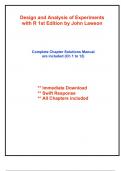Exam (elaborations)
Solutions for Design and Analysis of Experiments with R 1st Edition by Lawson (All Chapters included)
- Course
- Institution
Complete Solutions Manual for Design and Analysis of Experiments with R 1st Edition by John Lawson ; ISBN13: 9781439868133...(Full Chapters are included and organized in reverse order from Chapter 12 to 1)...1. Introduction 2. Completely Randomized Designs with One Factor 3. Factorial Designs 4....
[Show more]



